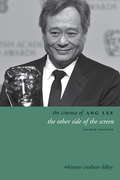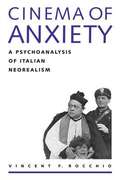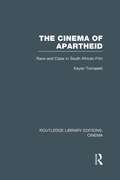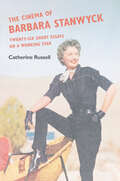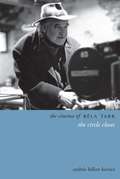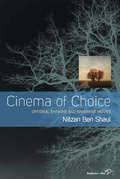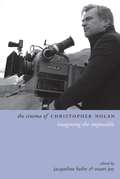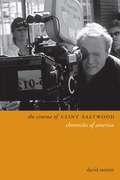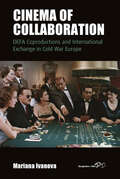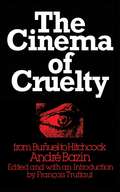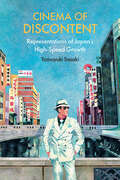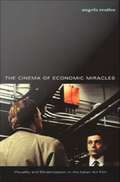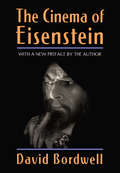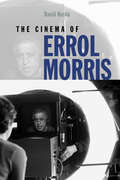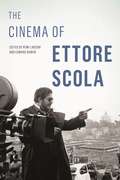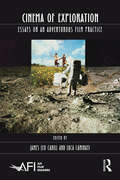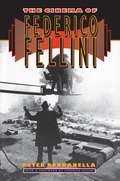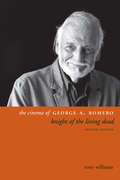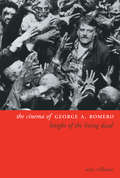- Table View
- List View
The Cinema of Ang Lee: The Other Side of the Screen, second edition
by Dilley Whitney CrothersSuggestive readings of gender and identity explore the international appeal of Ang Lee
The Cinema of Ang Lee: The Other Side of the Screen (Directors' Cuts)
by Whitney Crothers DilleyBorn in Taiwan, Ang Lee is one of cinema's most versatile and daring directors. His ability to cut across cultural, national, and sexual boundaries has given him recognition in all corners of the world, the ability to work with complete artistic freedom whether inside or outside of Hollywood, and two Academy Awards for Best Director. He has won astounding critical acclaim for Crouching Tiger, Hidden Dragon (2000), which transformed the status of martial arts films across the globe, Brokeback Mountain (2005), which challenged the reception and presentation of homosexuality in mainstream cinema, and Life of Pi (2012), Lee's first use of groundbreaking 3D technology and his first foray into complex spiritual themes.In this volume, the only full-length study of Lee's work, Whitney Crothers Dilley analyzes all of his career to date: Lee's early Chinese trilogy films (including The Wedding Banquet, 1993, and Eat Drink Man Woman, 1994), period drama (Sense and Sensibility, 1995), martial arts (Crouching Tiger, Hidden Dragon, 2000), blockbusters (Hulk, 2003), and intimate portraits of wartime psychology, from the Confederate side of the Civil War (Ride with the Devil, 1999) to Japanese-occupied Shanghai (Lust/Caution, 2007). Dilley examines Lee's favored themes such as father/son relationships and intergenerational conflict in The Ice Storm (1997) and Taking Woodstock (2009). By looking at the beginnings of Lee's career, Dilley positions the filmmaker's work within the roots of the Taiwan New Cinema movement, as well as the larger context of world cinema. Using suggestive readings of both gender and identity, this new study not only provides a valuable academic resource but also an enjoyable read that uncovers the enormous appeal of this acclaimed director.
The Cinema of Ang Lee
by Whitney Crothers DilleySuggestive readings of gender and identity explore the international appeal of Ang Lee
The Cinema of Ang Lee
by Whitney Crothers DilleySuggestive readings of gender and identity explore the international appeal of Ang Lee
Cinema of Anxiety: A Psychoanalysis of Italian Neorealism
by Rocchio Vincent F.Rocchio builds his analysis around case studies of the films Rome: Open City, Bicycle Thieves, La Terra Trema, Bitter Rice, and Senso. Through the lens of psychoanalysis, he challenges the traditional understanding of Neorealism as a progressive cinema and instead reveals the anxieties it encodes: a society in political turmoil, an economic system in collapse, and a national cinema in ruins; while war, occupation, collaboration, and retaliation remain a part of everyday life.
The Cinema of Apartheid: Race and Class in South African Film (Routledge Library Editions: Cinema)
by Keyan TomaselliThis study analyses the historical development of South African cinema up to he book's original publication in 1988. It describes the films and comments on their relationship to South African realities, addressing all aspects of the industry, focusing on domestic production, but also discussing international film companies who use South Africa as a location. It explores tensions between English-language and Afrikaans-language films, and between films made for blacks and films made for whites. Going behind the scenes the author looks at the financial infrastructure, the marketing strategies, and the works habits of the film industry. He concludes with a discussion of independent filmmaking, the obstacles facing South Africans who want to make films with artistic and political integrity, and the possibilities of progress in the future. Includes comprehensive bibliography and filmography listing all feature films made in South Africa between 1910 and 1985 together with documentary films by South Africans, non-South Africans, and exiles about the country.
The Cinema of Barbara Stanwyck: Twenty-Six Short Essays on a Working Star (Women’s Media History Now!)
by Catherine RussellFrom The Lady Eve, to The Big Valley, Barbara Stanwyck played parts that showcased her multidimensional talents but also illustrated the limits imposed on women in film and television. Catherine Russell’s A to Z consideration of the iconic actress analyzes twenty-six facets of Stanwyck and the America of her times. Russell examines Stanwyck’s work onscreen against the backdrop of costuming and other aspects of filmmaking. But she also views the actress’s off-screen performance within the Hollywood networks that made her an industry favorite and longtime cornerstone of the entertainment community. Russell’s montage approach coalesces into an engrossing portrait of a singular artist whose intelligence and savvy placed her center-stage in the production of her films and in the debates around women, femininity, and motherhood that roiled mid-century America. Original and rich, The Cinema of Barbara Stanwyck is an essential and entertaining reexamination of an enduring Hollywood star.
The Cinema of Béla Tarr: The Circle Closes (Directors' Cuts)
by András KovácsThe Cinema of Béla Tarr is a critical analysis of the work of Hungary's most prominent and internationally best known film director, written by a scholar who has followed Bela Tarr's career through a close personal and professional relationship for more than twenty-five years. András Bálint Kovács traces the development of Tarr's themes, characters, and style, showing that almost all of his major stylistic and narrative innovations were already present in his early films and that through a conscious and meticulous recombination of and experimentation with these elements, Tarr arrived at his unique style. The significance of these films is that, beyond their aesthetic and historical value, they provide the most powerful vision of an entire region and its historical situation. Tarr's films express, in their universalistic language, the shared feelings of millions of Eastern Europeans.
The Cinema of Béla Tarr: The Circle Closes
by András Bálint KovácsThe Cinema of Béla Tarr is a critical analysis of the work of Hungary's most prominent and internationally best known film director,
Cinema of Choice
by Nitzan Ben ShaulStandard Hollywood narrative movies prescribe linear narratives that cue the viewer to expect predictable outcomes and adopt a closed state of mind. There are, however, a small number of movies that, through the presentation of alternate narrative paths, open the mind to thoughts of choice and possibility. Through the study of several key movies for which this concept is central, such as Sliding Doors, Run Lola Run, Inglourious Basterds, and Rashomon, Nitzan Ben Shaul examines the causes and implications of optional thinking and how these movies allow for more open and creative possibilities. This book examines the methods by which standard narrative movies close down thinking processes and deliver easy pleasures to the viewer whilst demonstrating that this is not the only possibility and that optional thinking can be both stimulating and rewarding.
The Cinema of Christopher Nolan
by Jacqueline Furby Stuart JoyOver the past fifteen years, writer, producer and director Christopher Nolan has emerged from the margins of independent British cinema to become one of the most commercially successful directors in Hollywood. From Following (1998) to Interstellar (2014), Nolan's films have explored the philosophical concerns of cinema articulated through a distinctive cerebral style that is marked by a frequent experimentation with non-linear storytelling, and yet remains integrated within classical Hollywood narrative and genre frameworks. Through the contextualization and close readings of each of his films, this collection brings together academic work from a range of disciplines to examine the director's central themes and preoccupations -- memory, time, trauma, masculinity and identity -- whilst also offering analyses of otherwise marginalized aspects of his work, such as the function of music, video games and the impact of IMAX and other new technologies.
The Cinema of Christopher Nolan: Imagining the Impossible (Directors' Cuts)
by Furby Jacqueline Joy StuartOver the past fifteen years, writer, producer and director Christopher Nolan has emerged from the margins of independent British cinema to become one of the most commercially successful directors in Hollywood. From Following (1998) to Interstellar (2014), Christopher Nolan's films explore philosophical concerns by experimenting with nonlinear storytelling while also working within classical Hollywood narrative and genre frameworks. Contextualizing and closely reading each of his films, this collection examines the director's play with memory, time, trauma, masculinity, and identity, and considers the function of music and video games and the effect of IMAX on his work.
The Cinema of Clint Eastwood: Chronicles of America (Directors' Cuts)
by David SterrittHe became a movie star playing The Man With No Name, and today his name is known around the world. Measured by longevity, productivity, and profits, Clint Eastwood is the most successful actor-director-producer in American film history. This book examines the major elements of his career, focusing primarily on his work as a director but also exploring the evolution of his acting style, his long association with screen violence, his interest in jazz, and the political views – sometimes hotly controversial – reflected in his films and public statements. Especially fascinating is the pivotal question that divides critics and moviegoers to this day: is Eastwood a capable director with a photogenic face, a modest acting talent, and a flair for marketing his image? Or is he a true cinematic auteur with a distinctive vision of America's history, traditions, and values? From A Fistful of Dollars and Dirty Harry to Million Dollar Baby and beyond, The Cinema of Clint Eastwood takes a close-up look at one of the screen's most influential and charismatic stars.
The Cinema of Clint Eastwood
by David SterrittHe became a movie star playing The Man With No Name, and today his name is known around the world. Measured by longevity, productivity, and profits, Clint Eastwood is the most successful actor-director-producer in American film history. This book examines the major elements of his career, focusing primarily on his work as a director but also exploring the evolution of his acting style, his long association with screen violence, his interest in jazz, and the political views - sometimes hotly controversial - reflected in his films and public statements. Especially fascinating is the pivotal question that divides critics and moviegoers to this day: is Eastwood a capable director with a photogenic face, a modest acting talent, and a flair for marketing his image? Or is he a true cinematic auteur with a distinctive vision of America's history, traditions, and values? From A Fistful of Dollars and Dirty Harry to Million Dollar Baby and beyond, The Cinema of Clint Eastwood takes a close-up look at one of the screen's most influential and charismatic stars.
Cinema of Collaboration: DEFA Coproductions and International Exchange in Cold War Europe (Film Europa #21)
by Mariana IvanovaFrom their very inception, European cinemas undertook collaborative ventures in an attempt to cultivate a transnational “Film-Europe.” In the postwar era, it was DEFA, the state cinema of East Germany, that emerged as a key site for cooperative practices. Despite the significant challenges that the Cold War created for collaboration, DEFA sought international prestige through various initiatives. These ranged from film exchange in occupied Germany to partnerships with Western producers, and from coproductions with Eastern European studios to strategies for film co-authorship. Uniquely positioned between East and West, DEFA proved a crucial mediator among European cinemas during a period of profound political division.
The Cinema of Cruelty: From Buñuel to Hitchcock
by André Bazin François TruffautPerhaps the single most important voice of cinema in the twentieth century, André Bazin profoundly influenced the development of the scholarship that we know now as film criticism. Bazin has acutely analyzed the cinematic values of our time, extending to his international audiences "the impact of art for the understanding and discrimination of his readers."The depth and logic of his commentary has elevated film criticism to new heights. The reputation of André Bazin continues to grow as his writings are published and studied by filmmakers and filmgoers alike. Often referred to as the Edmund Wilson of film, Bazin was more than a critic. "He made me see certain aspects of my work that I was unaware of," said Luis Buñuel. "He was our conscience," wrote Jean Renoir. "He was a logician in action," echoed François Truffaut.In The Cinema of Cruelty, François Truffaut, one of France's most celebrated and versatile filmmakers, has collected Bazin's writings on six film "greats": Erich von Stroheim, Carl Dreyer, Preston Sturges, Luis Buñuel, Alfred Hitchcock, and Akira Kurosawa. The result is a major collection of film criticism.
Cinema of Discontent: Representations of Japan's High-Speed Growth (SUNY series, Horizons of Cinema)
by Tomoyuki SasakiFrom the mid-1950s to the mid-1970s, Japan experienced an unprecedented level of economic growth, transforming itself from a war-devastated country to a global economic power. Our image of postwar Japan has been shaped by this event, and we tend to see its history as a story of great national success. Cinema of Discontent challenges this view and details the tensions generated by massive and intense capitalist development through analyses of popular cinema produced during the era of high-speed growth. The films discussed in this book, directed by Kawashima Yūzō, Masumura Yasuzō, Inoue Akira, Ezaki Mio, and Kumashiro Tatsumi, attracted broad audiences yet remain understudied. Cinema of Discontent contextualizes these films in relation to the politics, economy, intellectual discourse, and cultural texts of the time. By doing so, it demonstrates how these films address problems immanent to Japan's postwar capitalism, including uneven development, increasing corporate control over individuals, precarious and contingent work, and militarized peace and prosperity.
The Cinema of Economic Miracles: Visuality and Modernization in the Italian Art Film
by Angelo RestivoThe Italian art cinema of the 1960s is known worldwide for its brilliance and vitality. Yet rarely has this cinema been considered in relation to the profound economic and cultural changes that transformed Italy during the sixties--described as the "economic miracle. " Angelo Restivo argues for a completely new understanding of that cinema as a negotiation between a national aesthetic tradition of realism and a nascent postmodern image culture. Restivo studies numerous films of the period, focusing mainly on the works of Pier Paolo Pasolini and Michelangelo Antonioni. He finds that these auteurs' films reworked the neorealist aesthetic developed in the 1940s and 1950s, explored issues brought to the fore by the subsequent consumer boom, and presaged developments central to both critical theory and the visual arts in the 1980s and 1990s. Drawing on the theories of Lacan, Zizek, Benjamin, Foucault, Jameson, and Deleuze, he shines new light on such films as Pasolini's Accattone and Teorema, and Antonioni's Red Desert and Blow-Up. Restivo's model for understanding the relationship of the 1960s Italian art film to its cultural contexts also has implications that extend to the developing national cinemas of countries such as Brazil and Taiwan. The Cinema of Economic Miracles will interest scholars and students in all areas of film studies, especially those studying theories of the image, national cinema theory, and Italian cinema, and to those engaged in poststructuralist theory, philosophy, and comparative literature.
The Cinema of Eisenstein
by David BordwellThe Cinema of Eisenstein is David Bordwell's comprehensive analysis of the films of Sergei Eisenstein, arguably the key figure in the entire history of film. The director of such classics as Potemkin, Ivan the Terrible, October, Strike, and Alexander Nevsky, Eisenstein theorized montage, presented Soviet realism to the world, and mastered the concept of film epic. Comprehensive, authoritative, and illustrated throughout, this classic work deserves to be on the shelf of every serious student of cinema.
The Cinema of Errol Morris (Wesleyan Film)
by David ReshaThe Cinema of Errol Morris offers close analyses of the director's films--from box office successes like The Thin Blue Line and The Fog of War to Morris's early works like Vernon, Florida and controversial films like Standard Operating Procedure. Film scholar David Resha's reappraisal of Morris's films allows us to rethink the traditional distinction between stylistically conservative documentaries, which are closely invested in evidence and reality, and stylistically adventurous films, which artfully call to question such claims of nonfiction and truth. According to Resha, Errol Morris does not fit neatly in this division of the documentary tradition. Rather, his experiments with documentary conventions constitute another way to investigate reality--in particular, to examine the ways in which his subjects understand, and misunderstand, themselves and the world around them. Seen within the nonfiction tradition, an Errol Morris documentary is a flexible form of lively, engaging storytelling and shrewd, cutting, in-depth reportage.
The Cinema of Ettore Scola (Contemporary Approaches to Film and Media Series)
by Edward Bowen Rémi Lanzoni Mariapia Comand Fabrizio Cilento Millicent Marcus Francesca Borrione Christian Uva Pierre Sorlin Brian Tholl Emiliano Guaraldo Federica Colleoni Marina Vargau Nicoletta Marini-Maio Dario Marcucci Luca Zamparini Gian Piero BrunettaThe Cinema of Ettore Scola offers contemporary perspectives on Ettore Scola (1931–2016), one of the premier filmmakers of Italian cinema. Scola was a crucial figure in postwar Italy as a screenwriter of comedies in the 1950s and 1960s who later became one of the country’s most beloved directors in the 1970s and 1980s with his bittersweet comedies and dramas on history, politics, and social customs. While Scola has received extensive attention from scholars based in Italy and France, Rémi Lanzoni and Edward Bowen’s edited volume is the first English-language book on Scola’s cinematographic career. The volume (containing fourteen chapters) is organized in four parts, the first two of which focus both on Scola’s contributions to Comedy Italian Style—as a screenwriter and director—and his commentaries on the history of Italy, Rome, and the film industry. The second half of the book is divided into sections on Scola’s relationship to and use of place, politics, and legacy. Mariapia Comand’s chapter begins the volume with an exploration of the development of Scola’s narrative methods by examining his early work as an illustrator, ghostwriter, and screenwriter. Later, Brian Tholl approaches one of Scola’s best-known and most frequently studied films, Una giornata particolare, from a less-explored perspective, namely its commentary on surveillance and internal exile, or confino, during the fascist period. At the close of the volume is a broad-sweeping tribute to and reflection on Scola’s filmmaking by Gian Piero Brunetta, a leading historian of Italian cinema who developed a close relationship with Scola over the years, who reveals the varied narrative strategies linked to food that the director utilized for character development and social commentary. The Cinema of Ettore Scola makes Scola accessible to English-reading audiences and helps readers better understand his film style, the major themes of his work, and the representations of twentieth-century Italian history in his films.
Cinema of Exploration: Essays on an Adventurous Film Practice (AFI Film Readers)
by James Leo Cah Luca CaminatiDrawing together 18 contributions from leading international scholars, this book conceptualizes the history and theory of cinema’s century-long relationship to modes of exploration in its many forms, from colonialist expeditions to decolonial radical cinemas to the perceptual voyage of the senses made possible by the cinematic apparatus. This is the first anthology dedicated to analysing cinema’s relationship to exploration from a global, decolonial, and ecological perspective. Featuring leading scholars working with pathbreaking interdisciplinary methodologies (drawing on insights from science and technology studies, postcolonial theory, indigenous ways of knowing, and film theory and history), it theorizes not only cinema’s implication in imperial conquest but also its cutting-edge role in empirical expansion and experiments in sensual and critical perception. The collected essays consider filmmaking in cross-cultural contexts and films made in or about peoples in South America, Asia, Africa, Indigenous North America, as well as polar, outer space, and underwater exploration, with famous figures such as Jacques Yves Cousteau alongside amateur and scientific filmmakers. The essays in this collection are ideal for a broad range of scholars, graduate students, and advanced undergraduate students in cinema and media studies, cultural studies, and cognate fields.
The Cinema of Federico Fellini
by Peter BondanellaThis major artistic biography of Federico Fellini shows how his exuberant imagination has been shaped by popular culture, literature, and his encounter with the ideas of C. G. Jung, especially Jungian dream interpretation. Covering Fellini's entire career, the book links his mature accomplishments to his first employment as a cartoonist, gagman, and sketch-artist during the Fascist era and his development as a leading neo-realist scriptwriter. Peter Bondanella thoroughly explores key Fellinian themes to reveal the director's growth not only as an artistic master of the visual image but also as an astute interpreter of culture and politics. Throughout the book Bondanella draws on a new archive of several dozen manuscripts, obtained from Fellini and his scriptwriters. These previously unexamined documents allow a comprehensive treatment of Fellini's important part in the rise of Italian neorealism and the even more decisive role that he played in the evolution of Italian cinema beyond neorealism in the 1950s. By probing Fellini's recurring themes, Bondanella reinterprets the visual qualities of the director's body of work--and also discloses in the films a critical and intellectual vitality often hidden by Fellini's reputation as a storyteller and entertainer. After two chapters on Fellini's precinematic career, the book covers all the films to date in analytical chapters arranged by topic: Fellini and his growth beyond his neorealist apprenticeship, dreams and metacinema, literature and cinema, Fellini and politics, Fellini and the image of women, and La voce della luna and the cinema of poetry.
The Cinema of George A. Romero
by Tony WilliamsIn placing Romero's oeuvre in the context of literary naturalism, the book explores the relevance of the director's films within American cultural traditions and thus explains the potency of such work beyond 'splatter movie' models. The author explores the roots of naturalism in the work of Emile Zola and traces this through to the EC Comics of the 1950s and on to the work of Stephen King. In so doing, the book illuminates the importance of seminal Romero texts such as Night of the Living Dead (1968), Creepshow (1982), Monkey Shines (1988), The Dark Half (1992). This study also includes full coverage of Romero's latest feature, Bruiser (2000), as well as his screenplays and teleplays.
The Cinema of George A. Romero: Knight of the Living Dead (Directors' Cuts)
by Tony WilliamsThe Cinema of George A. Romero: Knight of the Living Dead is the first in-depth study in English of the career of this foremost auteur working at the margins of the Hollywood mainstream in the horror genre. In placing Romero's oeuvre in the context of literary naturalism, the book explores the relevance of the director's films within American cultural traditions and thus explains the potency of such work beyond 'splatter movie' models. The author explores the roots of naturalism in the work of Emile Zola and traces this through to the EC Comics of the 1950s and on to the work of Stephen King. In so doing, the book illuminates the importance of seminal Romero texts such as Night of the Living Dead (1968), Creepshow (1982), Monkey Shines (1988), The Dark Half (1992). This study also includes full coverage of Romero's latest feature, Bruiser (2000), as well as his screenplays and teleplays.
